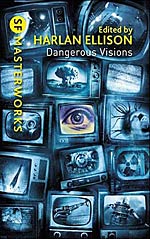
![]() BigEnk
BigEnk
1/4/2025
![]()
Dangerous Visions is a historically significant anthology that arrived on the scene in 1967. The central shtick of this enormous anthology is that every story (all of them published here for the first time) would have been too 'dangerous' to publish elsewhere, mostly because of their graphic and/or sexual content. Dangerous Visions apparently had a large impact on the genre at the time, changing the way that readers perceived the genre, opening new doors for what was acceptable for publishers to print. I have no doubt that this is so even though I was born almost 30 years after its publication. While I appreciate this historical context, I'll be talking about Dangerous Visions within the context of the present day from here on.
In this current day context, it's a rough read. Lets start with the stories themselves. Overall I found them on average to be unremarkable and forgettable. There were no standout masterpieces, though certainly there are some that are above average. PKD's story Faith of Our Fathers was very readable if not his best work, Gonna Roll the Bones by Leiber was a great exercise in evocative language, Laumer's Test to Destruction was a well paced action story, Carcinoma Angels by Spinrad was humorous and a different take on the 'dangerous' theme, and Delaney's Aye, and Gomorrah... was perhaps the best written, if not the best idea. The anthology strengthens over the last hundred or so pages, perhaps because it contains a lot of contributions from noteworthy authors.
However, like I said, a lot of the stories aren't up the standard that I expected for such a highly praised anthology. A large number are simply so unremarkable that I had to return to them immediately after finishing the book simply to refresh remember what they were about. A bad sign. Even worse, many of the stories were downright terrible. Many stories are unbearably dated in social outlooks with plenty of sexism, homophobic, casual incest, and pedophilia to go around. Sometimes these topics were brought up seemingly out of nowhere, which left them feeling auxiliary to everything else. The stories from Aldiss, Anderson, Silverberg, and Sturgeon are all like this. I began to believe that many of the stories were 'punched-up' to fit the 'dangerous' theme of the book, rather than finding works that relied on their 'dangerous' idea as a crucial structural component. Other stories were simply confusing, poorly written, and out of place. Ellison included a lot of stories from his personal friends in the anthology (Howard Rodman, Joe L. Hensley, Henry Slesar), who may have had writing careers or hobbies, but certainly did not seem to have background in writing SF. This is frustrating because in 1967, at the height of the new wave, there was such a wealth of excellent writers. It doesn't seem like you'd be forced to reach into your personal connections to fill out an anthology (which is already too long).
The other part of Dangerous Visions that stands out is how much Ellison inserts himself into the anthology beyond his one literary contribution. There are introductions before every story, which is common for anthologies. In Dangerous Visions these introductions are typically very long, sometimes longer than the stories themselves. Ellison spends a lot of time talking about himself in these introductions, typically in self-aggrandizing ways. Regardless of how you feel about his writing, Ellison comes off as a contemptible person, arrogant and self-involved to the point of delusion in some of these introductions. It's clear that Ellison was a much better writer than an editor or person. I wish that Ellison had done some self -reflection before publication, and let the work of the writers speak for themselves a bit more. Ellison also insisted that every writer make an afterword about their work. This could be a good idea, but if half the writers make it clear that they don't really want to be writing it, either with a lack of substance or directly with their words, maybe you should scrap the whole idea. I can see this concept being good if done with more willing participants. Readers so rarely get firsthand perspective from writers about their work unless they go seeking it from outside sources. However, there is an argument to be made that the work should speak for itself, and any afterword writers make would just be rehashing something that doesn't need to be rehashed.
In the year 2024 Dangerous Visions just doesn't hold up any more. It's a book of shaky structural integrity due to its quality issues, that ultimately gets blown down by the person who put it together in the first place. It took me over a year to finish it, in no small part because I struggled to gain any momentum moving through the dated material. I think that Dangerous Visions is best left behind the glass of its museum display case. Sometimes we should acknowledge the importance of a work historically, while also understanding that the material itself is well past its expiration date.